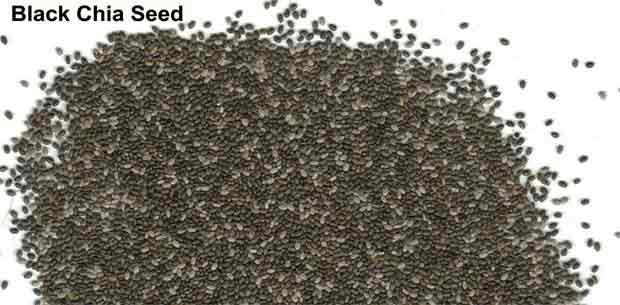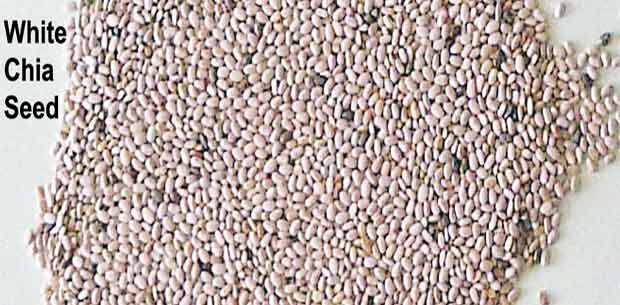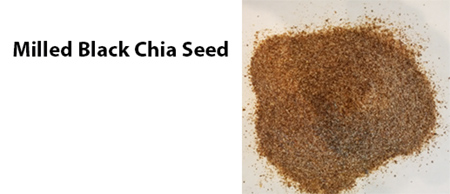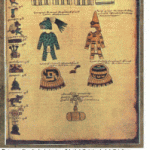Chia – History of this Ancient Crop
At the time of the Spanish conquest, Mesoamerica had at least 29 domesticated botanical species, each having a different use. Of these, four stood out from a nutritional point of view, and these were the basis of the daily diet. The four crops were: maize (corn), beans, chia, and amaranth. Hence chia can be considered an ancient crop.
The importance of these four crops in Aztec diets is supported by Codices written about the time the conquest of America took place. Among these is the Florentine Codex which was written between 1548 and 1585 by Fray Bernardino de Sahagun, and is titled the General History of the Things of New Spain. The entire 12 volume work, written in Nahuatl (the native language) and Spanish, is in the Medicca Laurentziana library in Florence, Italy. Various aspects of Aztec chia production and use are described in this monumental work.
There is evidence that chia seeds were first used as a food as early as 3500 B.C., and served as a cash crop in central Mexico between 1500 and 900 B.C. Chia seeds were eaten as a grain alone or mixed with other grains, drank as a beverage when placed in water, ground into flour, included in medicines, and pressed for oil and used as a base for face and body paints. Aztec rulers received chia seeds as an annual tribute from conquered nations, and the seeds were offered to the gods during religious ceremonies.
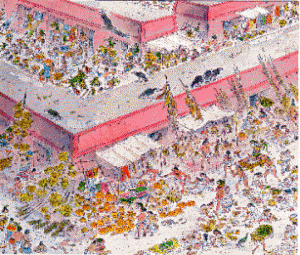
Aztec food market at Tecnochitlan
(Source: Latin American Studies Program, Rose-Hulman Institute of Technology)
The Aztecs made great advances in agriculture. As an example consider their unique system of growing crops. Using what they learned from their predecessors, the Toltecs, they were able to turn the marshy grounds that they lived on into firm soil. They wove bark from trees into large mats and anchored these to stakes in the lake. They covered the mats with soil and grew amaranth, beans, chia and maize on these man-made islands which were called chinampas or hanging gardens.
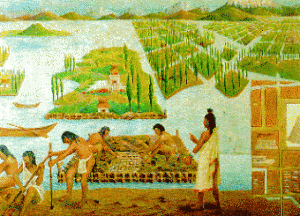
Ancient Aztecs tending to chinampas
(Source: Latin American Studies Program, Rose-Hulman Institute of Technology)
As was documented in the Codex Mendoza, written in 1541, the city of Tenochtitlan received as tributes from conquered nations a minimum of 6,360 tons of maize, 4,410 tons of beans, 4,410 tons of chia, and 3,780 tons of amaranth, annually. The city also harvested an average of 3,335 tons of maize, chia, beans, and amaranth from the 9,000 hectares of chinampas surrounding it.
It is interesting to note that the Aztec diets, when derived solely from these four grains, meet today’s dietary requirements as set out by the Food and Agriculture Organization-World Health Organization (FAO-WHO).
Chia was one of the main dietary components of not only the Aztecs, but also of another great Pre-Columbian civilization that developed in Mesoamerica, the Mayans. The Mexican State of Chiapas, located within the limits of what was ancient Mayan territory, derives its name from the Nahuatl word Chiapan which means “river of chia”. This indicates that existence of chia as a crop in this region also extends from very early times.
Pre-Columbian Codices reveal that 4,000 tons of chia were paid annually
as tributes to the Aztec Empire
The conquest of America repressed the natives, suppressed their traditions, and destroyed much of the intensive agricultural production system that was in place. Many crops that had held a major role in Pre-Columbian American diets were banned by the Spanish because of their close association with religion, and were replaced by foreign species (wheat, barley, carrots, etc) which were in demand in Europe.
In recent years chia seeds were only consumed by small groups of people. Primarily they were mixed in water, along with lemon juice and sugar, and consumed as a refreshing beverage in Mexico, Guatemala and Nicaragua as well as the southern USA (California and Arizona).
It is interesting to note that 500 years later, modern science has concluded that Pre-Columbian diets were superior to present day diets. Formerly forced into obscurity, chia seeds are now emerging as a new food, and offer a great opportunity to improve human nutrition by providing a natural source of omega-3 fatty acids, antioxidants and dietary fiber.
From Ancient Aztec Culture to Modern Society
Although chia (Salvia hispanica L.) was an important crop during pre-Columbian times, its cultivation decreased following the discovery of America. Until recently this species was cultivated only on a few hectares in its native location. Additionally there was little possibility of increasing the planted area in these regions due to social and political factors which subdivided the land into small farms, and which brought about the corn culture and the increased use of the popular Mexican “tortillas”.
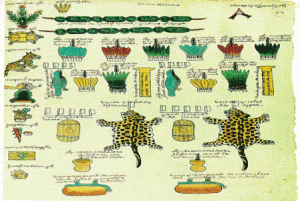
Annual tributes to Tenochtitlan
(Source: Latin American Studies Program, Rose-Hulman Institute of Technology)
The lack of a reliable source of chia led a group of growers and researchers to unite and work together under the auspices of the Northwestern Argentina Regional Project, to initiate a chia research and development program. This effort included selection of new production areas and the development of practices aimed at bringing chia to the market as a new commercially available food. Today chia is grown in different countries on a commercial basis. Producing the crop in different, distinct areas decreases climatic and political risks, and avoids concentrating the harvest season.
Recent research explains why ancient mesoamerican civilizations considered chia a basic component of their diet. Chia’s composition and nutritional value gives it a very high potential for use in human food and animal feed. Thus new technological information has provided an excellent opportunity for creating an agricultural industry which can offer a “new, old crop” to the world.



